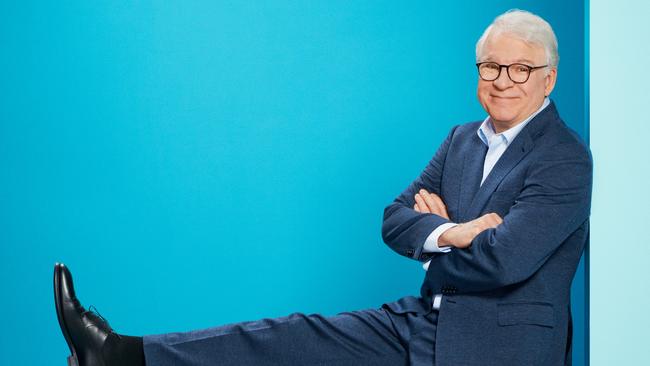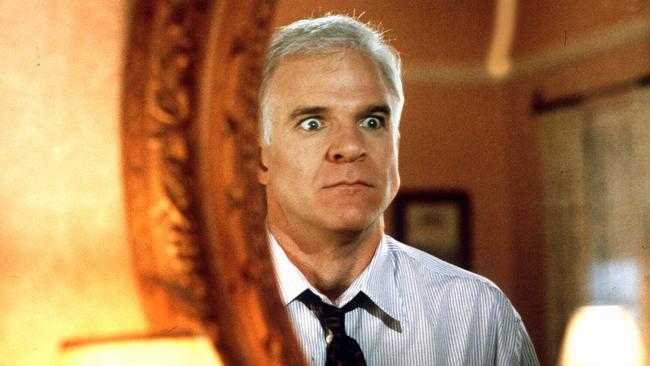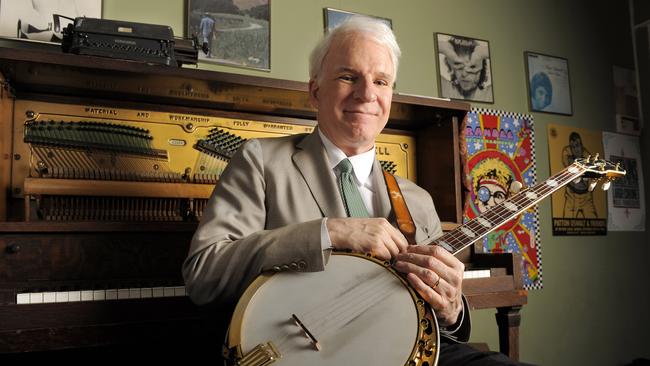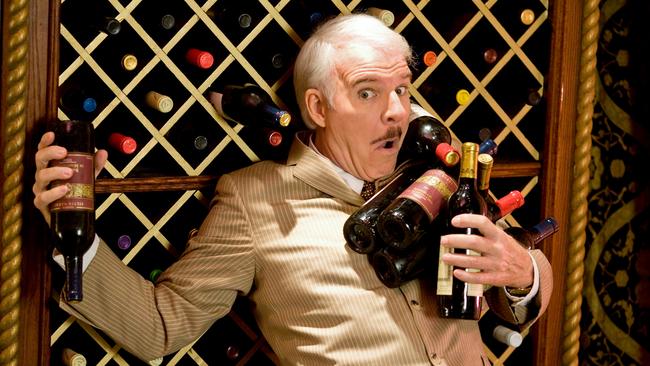It’s STEVE! Martin on stand-up comedy, movies, TV and fatherhood
When Steve Martin quit stand-up comedy in 1981, he was drawing the biggest audiences ever seen for a comedy act. He pivoted to movies, emulating his comedic heroes, and found huge success. Now – a glimpse into his third act.

When Steve Martin quit stand-up comedy in 1981, he was drawing the biggest audiences ever seen for a comedy act, selling out stadium-after-stadium, and had the top charting comedy albums. He had reinvented comedy with a zany act that combined music and magic with balloon animals, juggling and dancing, all with an arrow through his head.
He pivoted to movies, emulating his comedic heroes, beginning with The Jerk (1979) and iconic performances in films such as ¡Three Amigos! (1986), Little Shop of Horrors (1986), Planes, Trains & Automobiles (1987), Dirty Rotten Scoundrels (1988) and Father of the Bride (1991). After four decades, he lost interest in films, too.
This career in two acts is chronicled in a documentary by Academy Award-winning director Morgan Neville with glimpses of the third act that combines writing; performing with the Steep Canyon Rangers; a live show with Martin Short; the hit series Only Murders in the Building (2021 –); and being a father.
Martin, intensely private and nothing like the “wild and crazy guy” on Saturday Night Live, insists he is not a good interviewee. But when he beams in via Zoom to talk about this new film with Neville, he could not be more friendly and engaging.
In the mid-1950s, at age 10, Martin started working at Disneyland selling guidebooks, and then in the magic shop. It opened a vista of opportunities. He was eager to be a performer and was soon combining music and magic at Knott’s Berry Farm’s Bird Cage Theatre. The act was so unique that it took time to find an audience.

“I had no other skills – and I wouldn’t call this even a skill – but it was the only thing I really could do,” Martin, 78, tells Review. “I loved show business. I was torn between becoming a professor, because I was interested in that, or a comedian. I thought, ‘Well, I’ll really feel bad if I don’t give show business a try.’ And so that’s really what it was. And then pretty soon that’s the only thing you do.”
The stand-up career started slowly. The routines, which often threw away the punchline, didn’t work everywhere. But he eventually found an audience for it – and they were fanatical. He was profiled in Rolling Stone and became a regular on The Tonight Show. By the late 1970s, crowds of 20,000-plus would fill venues to see him movin’ and groovin’ on stage, play the banjo, read comics, juggle kittens, pretend to be electrocuted and wear bunny ears.
“I know what you’re thinking: ‘Steve, how can you be so f--kin’ funny’,” he would say. He would open with, “It’s great to be here” and then move to other spots on stage and say, “No, it’s great to be here!” He would tell the audience he was mad at his elderly mother who asked for 10 dollars to buy food. “I said, ‘Hey, I work for a living!’” He would close with: “Well, we’ve had a good time tonight, considering we’re all going to die some day.”
Martin had found his voice as a comedian and captured the emerging Zeitgeist. But Martin admits not being ready for fame.
He could rarely go anywhere and not be recognised. People would yell out his catch phrase, “Well, excu-u-use me!” or sing the King Tut song. It was not the real him. Onstage Steve was not the same as offstage Steve.
“Those two things have nothing to do with each other,” Martin reflects. “People say, ‘How come you’re not funny off stage?’ I said, ‘If I was acting, now, the way I acted on stage, you would not want to be in this room.’ After getting offstage, there was so much pressure to be funny.”

Growing up, future director Neville listened to Martin’s comedy records, saw him perform in Las Vegas, watched the movies and read his books. The key was not just getting him to agree to participate in the documentary but also opening up. “I knew he was capable of getting pretty deep into his own story,” Neville, 56, says. “But was Steve willing to buy into it? And he was. I said to him that making a documentary is like an act of therapy, because I’m asking about these important things in your life and trying to make sense of it.
“But it’s also a therapy for me. We’re all trying to work through issues and asking these questions.”
The first part focuses on Martin’s early life and stand-up, combining archival footage with personal records and animations. Martin’s narration overlays the film. But it is not until the second part, centred on his movie and writing career, that we see Martin interviewed, at home, cycling, rollerblading and backstage before performances.
There are interviews with Jerry Seinfeld, Lorne Michaels, Tina Fey, Frank Oz, Eric Idle and Diane Keaton. It is pure joy to see Martin swap jokes with Short. At home, playing cards and cooking, he is not entirely at ease, but his warmth and humility is evident.
Martin’s career accelerated after he started writing for other comedians, appearing on television and opening for musical acts such as Linda Ronstadt and Sonny & Cher. But his parents, Glenn and Mary, were not supportive.
Older sister Melinda says there was never any parental affection growing up in the 1940s and 50s. It may partly explain Martin’s anxiety in his 30s, and his constant search for happiness and fulfilment in life. Martin says he took his father’s negative comments about his career as only he could – as encouragement.
“A lot of those negative comments came in the 60s and 70s, and there was also something else happening, which was love beats and bell bottoms and long hair,” Martin explains. “As a parent coming out of the 40s and 50s, that’s not what you want to see your kid doing … but also my material was not the comedy that they were used to.”
The film hews closely to Martin’s memoirs – Born Standing Up (2007) and Number One is Walking (2022). The first gives a moving account of the difficult relationship with his parents and the efforts he went to understand them and, eventually, reconcile.
“But eventually, through the years, you know, they’re my parents and I started making conscious efforts to connect,” he adds. “And that worked out. I’d see them every week. I’d take them to lunch and have discussions and talk and, you know, there’s a repair going on.”

In the 1980s and 90s, Martin’s films seared themselves into the memories of a new generation. Alongside classic comedies were deeper films such as Roxanne (1987) and LA Story (1991). There were hits and many misses, with Mixed Nuts (1994), Sgt Bilko (1996) and The Pink Panther (2006) among them.
The chance to follow the path of comedians Peter Sellers, Bob Hope, Jerry Lewis, Oliver Hardy and Stan Laurel, and Lou Abbott and Bud Costello, inspired Martin to make movies. He worked alongside some of the great comedians of his own era, including Chevy Chase, John Candy, Goldie Hawn, Eddie Murphy, Catherine O’Hara, Dan Aykroyd and, of course, Short.
“We’re really, really close friends who aren’t that close,” Martin jokes about Short. “Marty and I love working together and we love gossiping together, and that’s why we’ll probably be working together for a long time – because it’s, you know, fun.”
You need to make 40 movies to get five good ones, Martin argues, and after a string of poor reviews, falling box office and more offers of supporting roles, he “ran out of gas”. He lost interest in movies at the same time that movies lost interest in him, he suggests. Asked which films he is most proud of, Martin says there are different reasons for different films.
“I liked Father of the Bride because I was working with Marty and Diane Keaton and Nancy Myers and Charles Shyer and we had a good time,” he says. “Before that, you know, Roxanne was the first film I wrote alone. And it was nice working with Michael Caine and Glenne Headly and Frank Oz on Dirty Rotten Scoundrels in the south of France.”
Neville makes the point that Martin is the film father of 27 kids. Father of the Bride and its sequel is iconic, but there are others, too, including Parenthood (1989) and Cheaper by the Dozen (2003) where he played the ideal Dad. It was not until much later in life that he actually became father to a now 11-year-old daughter with Anne Stringfield.
“I got used to being around kids because I was not around any kids ever, and I didn’t want to be,” Martin says. “But, you know, a film offers the opportunity to be around kids when they are at their best. And if they are crying, they are replaced by their twin who isn’t crying. So that’s what that did and I thought, oh, these objects are actually kind of fun.”
Now, thanks to Selena Gomez, Martin has a new audience of Gen Z and Millennials watching Only Murders in the Building. His character, semi-retired actor Charles-Haden Savage, like that of many he portrayed on the big screen, has a longing for something: recognition, respect, dignity, love.
“When I pitched the show to the producers, it was just an idea,” Martin notes. “Later they came and said, ‘Would you be in it?’ I thought, ‘Well, I’ll do it if Marty does it.’ So, I called Marty, I said, ‘Do you want to do this?’ He goes, ‘Yeah, I’ll do it’. I didn’t expect him to say that. And then it was on.”
Martin says it is hard to step back and analyse his life. “It’s hard work that you don’t know you are doing,” he explains. “You’re just doing it.” He remains a very private person. One area that he rarely discusses is his extensive art collection, which includes Australian Indigenous art, alongside works by the masters: Pablo Picasso, Edward Hopper, Georges Seurat, and others.
He leans into the notion that he is now in the third act of his career, with a popular TV show, performing live music and comedy, writing and composing, and fatherhood. It has been a life of reinvention but he is not yet ready to retire.
“Honestly, my goal now is to be half-busy,” Martin jokes. “So that’s kind of the way I see it. Not un-busy, not nothing. I want to be working. I do like it. I get a big thrill from it. This is my retirement: doing a television show, touring with Marty and writing some songs. So, the answer in case it’s unclear is: I am not retiring and I’m not looking forward to retirement.”
STEVE! (martin) a documentary in 2 pieces premieres on
Apple TV+ on March 29.

